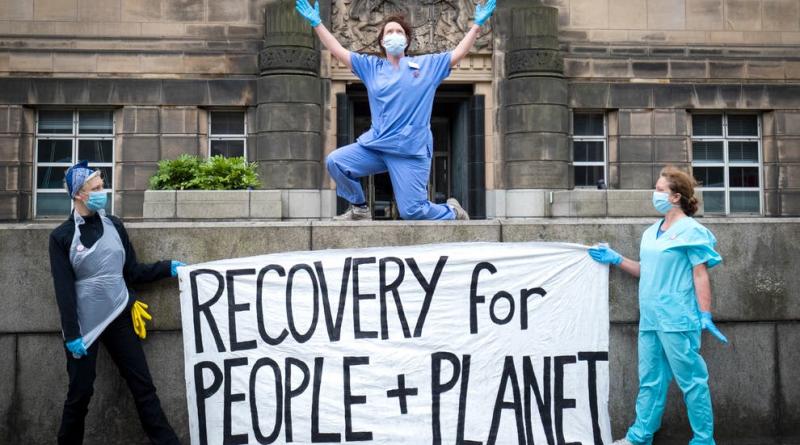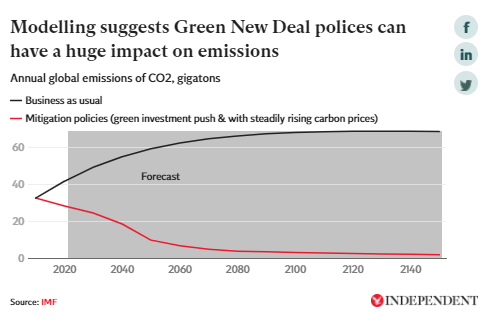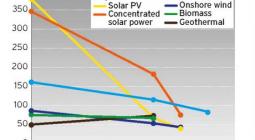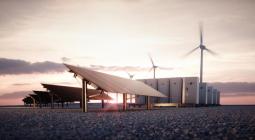What would a ‘Green New Deal’ for a post-pandemic world economy look like?

Analysis: What policies do we need to see implemented by politicians, what actions from business, what changes in our own everyday lives? Ben Chu explains
The coronavirus pandemic has delivered the biggest shock to the world economy on modern record. The only comparable crisis was the Great Recession of the 1930s. The job of rebuilding the economy in the wake of this disaster will be of epic proportions.
Yet the massive rebuilding job comes at a time when analysts, economists and activists around the planet were, already, urging a fundamental shift in the configuration of our economies to deal with the global climate crisis.
It’s almost universally accepted that we need to essentially decarbonise our economies and end our use of fossil fuels this century in order to prevent runaway and catastrophic global warming.
That was the agreement made by leaders representing virtually all the nation states around the world at the Paris Climate Change Accords in 2015.
So, in that sense, the rupture of the pandemic provides something of an opportunity.
Many are urging policymakers and politicians now to seize the chance to implement a “Green New Deal”, to rebuild the global economy over the coming years in a way that puts us decisively on a path to decarbonisation.
What policies do we need to see implemented politicians, what actions from business, what changes in our own everyday lives?
It’s useful to think of the original “New Deal”.
This was a revolutionary set of policies put in place by the US president Franklin Roosevelt after that previous great global economic crash in the 1930s.
It involved new public works schemes to reduce mass unemployment, large-scale state investment in infrastructure to provide valuable new public goods, and the creation of an unprecedentedly broad social safety net and suite of regulatory policies to protect citizens.
It is the scale and comprehensiveness of that economic and social reconstruction programme that inspires advocates of a Green New Deal.
As in the 1930s, one major social benefit of a Green New Deal would be job creation.
Unemployment around the world has surged in this crisis. The International Labor Organisation estimates that in 2020, 8.8 per cent of global working hours were lost relative to 2019, equivalent to 255 million full-time jobs.
And happily, renewable energy production (at least at the moment) is more “job intensive” than in fossil fuels which suggests that this transition should boost overall employment.

A mass programme of insulating millions of buildings and retrofitting billions of homes with low or zero carbon heating systems, such as air-source heat pumps or electric boilers would also be a source of new jobs and incomes for workers.
A green fiscal stimulus would support global GDP and employment during the recovery from the COVID-19 crisis,” argue International Monetary Fund researchers.
A Green New Deal would require governments to scrap all remaining fossil fuel subsidies for firms and households and to increase taxes on carbon emission-intensive activities such as air travel and driving petrol or diesel cars – many of which will face strong resistance from various lobbies.
To counter that lobbying effort and win the public opinion battle, states will need to take decisive and rapid action to support household incomes through the transition, redistributing revenues from carbon taxes to less well-off consumers hit by rising living costs.
Governments would also need to play a much-expanded role in funding and guaranteeing the retraining of many fossil-fuel economy workers for roles in the new zero-carbon economy. Regions and countries that have a high concentration of fossil-fuel related jobs will need particular assistance.
A Green New Deal without a “just transition” will fail.
For households, a Green New Deal would require lifestyle shifts such as eating less meat, heating homes differently, travelling differently and perhaps less. Some will resist these changes, but many will welcome the cleaner air and other health benefits. Lower air pollution from decarbonisation promises to help prevent hundreds of thousands of premature deaths a year.

But what should be the balance between state and market in a Green New Deal energy transition?
Some believe that governments should be in the driving seat, with the state directly investing public money in new infrastructure because private industry and private finance will not deliver.
“We have to get real and accept that, with some exceptions, the sector would not help finance a massive climate stabilisation project on terms that are acceptable and sustainable,” says the economist Ann Pettifor, author of The Case for The Green New Deal.
Yet others think that the private sector not only can, but should, provide most of the funding for a renewable energy transition, with states incentivising, even forcing, that investment through strict regulation and taxation.
They point out that if the government, for example, bans the sale of diesel cars, or gas boilers, it can have a revolutionary impact on the market without the state needing to manufacture electric cars or zero-carbon hydrogen boilers itself.
The appropriate balance between state and private sector low-carbon investment will likely vary between different countries. State money might be best deployed in funding research and development into nascent zero-carbon technologies.
In the end what matters is that the investments are made and, above all else, that decarbonisation is achieved.
A Green New Deal in the US is associated with progressive Democrats, but in the UK its main features have been embraced by the Conservative Party of Boris Johnson, who says he is aiming for a “green industrial revolution”. Parties of all shades across the European Union have subscribed to a “European Green Deal”.
A Green New Deal can be the property of both the left and the right, of statists and liberals. It need not be a culture-wars football.
The idea that governments can deliver a Green New Deal alone, without any participation of the private sector, or that markets can be left to solve the problem of climate change without the state, is to misunderstand the nature of the challenge.
A Green New Deal would demand a fundamental and simultaneous shift, requiring action from every government, every business and every household in the world.
10 February 2021
INDEPENDENT




